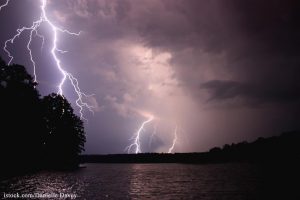The USDA is offering food safety tips for those affected by severe storms. Power outages from weather emergencies can cause food safety problems. The agency is also offering a video broadcast on this topic you can watch. FSIS also provides food safety information as storms progress from its Twitter feed @USDAFoodSafety.
 Before the storm, make sure you have appliance thermometers in your fridge and freezer. Safe temperatures are 40 degrees F or lower in the refrigerator, and 0 degrees F or lower in the freezer. Freeze water in one quart containers before the storm. This will ensure you have fresh water available, and the frozen containers can be used to help keep food in your fridge safe. Freeze leftovers and other items before the storm, since the freezer will keep food safer longer than the fridge. Know where you can get dry ice or block ice.
Before the storm, make sure you have appliance thermometers in your fridge and freezer. Safe temperatures are 40 degrees F or lower in the refrigerator, and 0 degrees F or lower in the freezer. Freeze water in one quart containers before the storm. This will ensure you have fresh water available, and the frozen containers can be used to help keep food in your fridge safe. Freeze leftovers and other items before the storm, since the freezer will keep food safer longer than the fridge. Know where you can get dry ice or block ice.
If the power goes out, keep the refrigerator and freezer doors closed as much as possible. A refrigerator will keep food safe for 4 hours, while a full freezer will hold a safe temperature for 48 hours (24 hours if half-full). Use ice to keep the fridge as cold as you can during an extended outage. Fifty pounds of dry ice can keep a fully stocked freezer cold for two days.
Check the temperature inside the fridge and freezer after the power goes back on. Discard perishable food that has been above 40 degrees F for two hours or longer. Check each food item. Throw out any food above 40 degrees F. If frozen food still has ice crystals, it can be refrozen.
Never taste a food to see if it’s safe. And when in doubt, throw it out.




